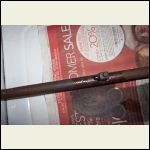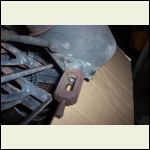|
| Author |
Message |
SE Ohio
Member
|
# Posted: 22 Dec 2010 17:17
Reply
I just purchased this kerosene stove for the "shack". I have quite a few spare parts and such, but cannot find much info online. Other than a good clean and making sure it doesn't drip kerosene, and adjusting the wick to burn, what else? Anybody have a manual, etc? A forum, perhaps? Old advertisements? My web searches turned up pretty empty.
|
|
larryh
Member
|
# Posted: 22 Dec 2010 17:37 - Edited by: larryh
Reply
I have a kerosene stove group devoted to just that topic. I use a boss three burner stove and had had all sorts of full sized ranges that used oil. I have never had the Lorain burner but its similar to many other short drum stoves. I saw a wick for one at a shop today, they show up from time to time. Main thing is to flush the lines with clean kerosene and run a heavy wire though the main line to get the years of gunk out. Also the wicks should raise up and down and often the metal carriers to the wick can become rusted in the burner rendering them not moveable. If you have that problem do not force the wick raiser you will damage the brass cogs and they have real problems.
Here is the link to the stove group, mention your stove when you request membership to jog my mind.
KeroseneHeaterandStoveCollector
We have a number of people that are still using various brand of oil stoves to cook on daily. I find that the style burner you have while having some advantages in changing the flame quicker than a needle valve or burner that raises the wick in an out of the oil level, it is also prone like the rest of the short drum burner to flaring up and sooting pans rather badly if any water boils over or drips in to the burner. A wick long chimney stove such as the boss I have on the home page or perfection brand and many others do not have that problem and are instantly adjustable to heat control. But any old oil range or cookstove is a fascinating thing too me. Too bad the oil is worse that it used to be and the price is so high today.
Larry
I can't get that link to work from my end. If you can't either go to yahoo groups and type kerosene stove in the search for groups and it should come up.
|
|
islandguy
Member
|
# Posted: 22 Dec 2010 19:57
Reply
also, always burn only 1st grade fresh kerosene, it should look like water, otherwise you will produce more smoke and soot.
|
|
SE Ohio
Member
|
# Posted: 23 Dec 2010 19:52
Reply
I may join the stove forum, depends on how my restore goes.
Is there a compression fitting between the distributor line and the burner assembly on the Lorain? I cannot see any evidence of a gasket.
Looks like it is missing the back-splash.
Stove picture attached (no detail of seal area, sorry)
|
|
larryh
Member
|
# Posted: 23 Dec 2010 23:05
Reply
I would say without seeing the exact set up that all the stoves that have wick burners of this type the burner is tighten with a nut or large screw head that puts pressure on usually a lead thick washer that is pretty much invisible as its under the connecting point with the burner and the pipe. The new perfection stoves use a teflon washer which is the modern replacement for the lead ones so those are available from Schwartz Perfection in Berne Indiana. Also some mail order amish catalogs carry the parts for the new perfections as well.
Many stove companies made various versions of the two and three burner oookstove as they called them. Often offering a no back plain stove and some with a short back and many with high shelf full splash backs. Should you join the Kerosene Stove group, which I see the link is now working with, you would see a number of cooking stove catalogs which would show selections of these types of stoves. We do not however have a Lorain catalog in the mix at this time.
|
|
SE Ohio
Member
|
# Posted: 27 Dec 2010 19:52
Reply
Here are closeups of the distributor pipe fitting and the mating burner. The burner (female) side looks like a compression fitting. I haven't yet tried to see if there is a good seal just by tightening the burner bolt.
I've cleaned out each burner reservoir and removed some rust for easier wick movement. If the wicks are lowered too much they get stopped before going up all the way. The don't fit between the inner and outer burner surface easily, requiring the outer shell to be unscrewed so the wick can go up to the stop. I'll see how is does when the wick is wetted with kerosene.
I checked my kerosene supply. All "clear", no red stuff.
Lorain_Stove_003.JPG
| 
Lorain_Stove_008.JPG
|  |  |
|
|
larryh
Member
|
# Posted: 27 Dec 2010 23:25
Reply
Well, I knew I was not familiar with that exact burner set up. Loraine was one of the earliest set ups along this line so it stands that they would evolve as they became more popular. It appears from you photos that the burner has a sideways connection instead of up and down like most. I am guessing that the little side pipe looking piece is where the burner is tightened to the pipe. Is that part perhaps soft lead? Have you tightened the set screw firmly to see if that stops it from leaking?
If not then maybe you can improvise a way to make the connection seal. I don't think any parts I know of would work on it. I don't know if a very thin "O" ring might slip over it and cause a seal when the burner is tightened? Or perhaps a light coat of a oil proof pipe dope that might cause it to seal sort of like on a water pipe fitting you screw together? Just guessing here.
Your burner is most likely full of "gunk" in the bottom from years of sitting and being used. It can change the look of the brass burner a bit, if they are brass, but the Perfection and other stoves recommended boiling the burner in a pot with Borax Washing Powder". After a while in that a lot of oily material will turn loose and running a thin knife blade around inside the burner carefully with a thin rag on it should help to clean out the sides and bottom making the wick operate the full distance. Having oil in the line will also help it to drop down. Often that kind of wick with metal carrier has to be rotated a hair to get the cogs to line up with the wick carrier. Don't force it or you risk damage to the cogs. I think once the burner is free of residue it will accept the wick. Some wicks however are difficult to get to lower for one reason or the other and worse sometimes the get stuck in the down position which is no fun. Should that happen if you run a thin steak type knife down along the carrier and sort of put a little upward pressure on the wick it often will come up.
I hope you can get it working, have you checked out our Kerosene stove group, its possible someone there has experience with the burners you have?
Larry
|
|
SE Ohio
Member
|
# Posted: 30 Dec 2010 11:33
Reply
I've "applied" to the kerosene stove group.
I originally cleaned the burner reservoirs with soap and hot water with a narrow brush, but boiling them in a washing soda solution really cleaned things up. The water turned almost black. I changed the water several times with fresh soda and got them pretty clean.
The cogs seem to be in good shape. I've got several reservoirs as spares in any case. Some are missing the bottom lever that lifts the so-called "catalytic converter". These were originally soldered on, looks like the joints failed. My 180 watt gun was insufficient to get a good solder joint, so I went the JB Weld route. Despite the 600 degree working temp claim, the bond failed in the boiling mix (JB seems to loose tensile strength with increased temp). I'll reglue now that I'm done boiling. I don't really want to resolder with a torch for fear of damaging the reservoir solder joints.
I might post some more picts at the yahoo group.
|
|
|
larryh
Member
|
# Posted: 30 Dec 2010 13:35
Reply
What your lifting is actually referred to as the chimney that produces the heat. Perfection and others adapted the "Lift" lever to raise the chimney off the burner to light the wicks. The wick type burners were simply tilted by hand to light, as well as many of the short drum type you have on other latter brands. Its a nice feature though. My early perfection used it to also tilt the flame spreader a bit in order to easier get the wick to ignite and spread the flame around the wick.
I approved your request for the stove group. Some photo would be nice since I don't think we have much on Loraine burner stoves as yet.
|
|
islandguy
Member
|
# Posted: 30 Dec 2010 19:04
Reply
Electric arc soldering may help... it heats the immediate area being soldered so quickly, the heat doesnt have time to spread and de-solder nearby joints.
|
|
Anonymous
|
# Posted: 31 Dec 2010 20:34
Reply
If the JB Weld (US $4.xx or so) won't hold, then I'll consider finding a welder. Locally that means taking vacation time, as they seem to work bankers' hours.
Today we had nearly 60 degrees F here in Ohio, and I managed to paint the kerosene line and stacks with high temp paint. I should be able to reassemble tomorrow. Forecast calls for rain, glad I painted early today.
|
|
larryh
Member
|
# Posted: 1 Jan 2011 09:48
Reply
Three are some amish sources that repair stove burners, but mostly the Perfection or Boss burners. They may also do simple repairs such as leak repairs on others. Its not welding, its solder joints in these burners.
|
|
|

